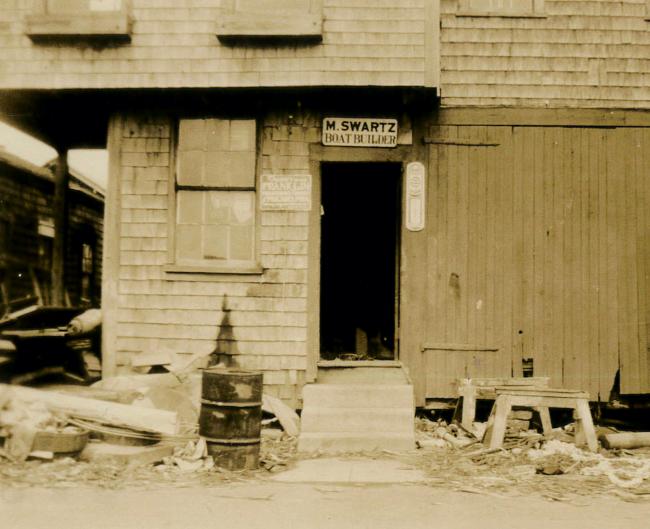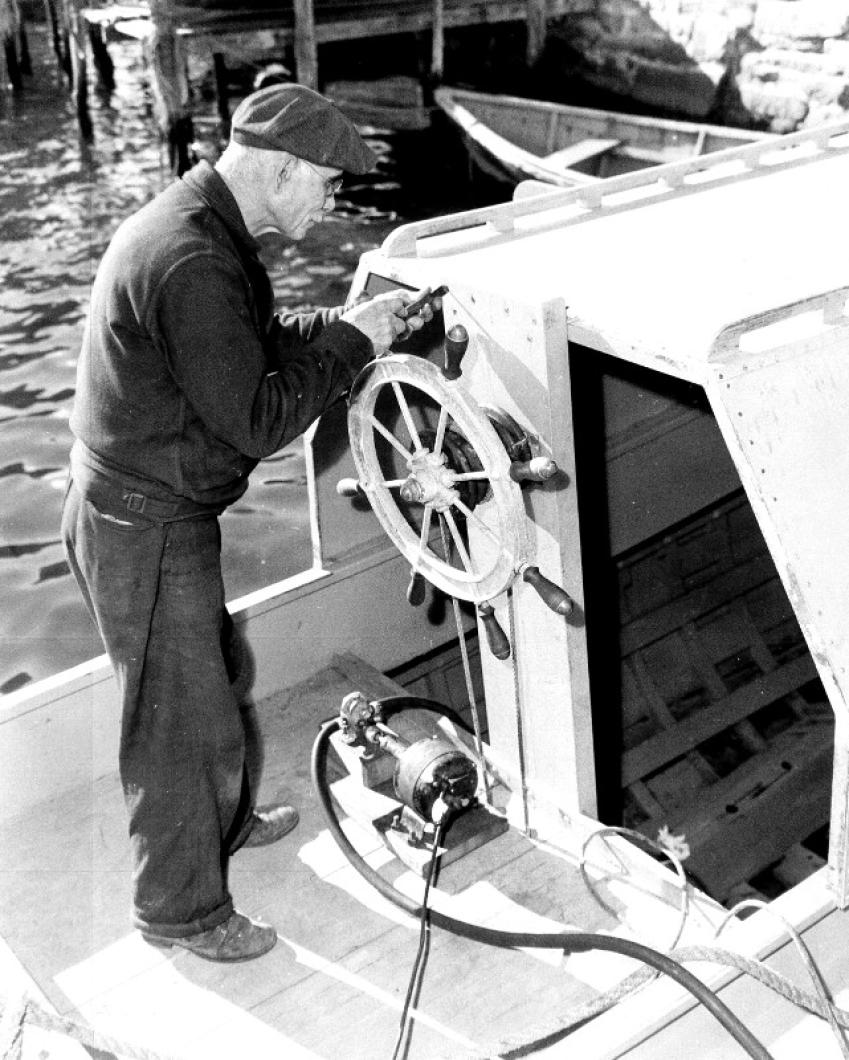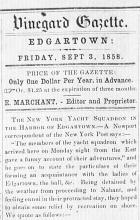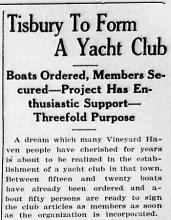Note: Mr. Leavens - visited M. S. Roberts and made notes of their talk. He had intended to write this interview as an article in the third person, but Mr. Roberts’ own personality so clearly emerged from the written memoranda that the author decided to write the interview in the first person, following as closely as possible the ideas and modes of expression of the man who sat for the portrait.
I was born in 1881 on Ox Pond Farm down Katama way. I had always wanted to be a house carpenter as far back as I can remember. When I was 17 years old I spent most of my time watching a house being built nearby, instead of doing the farm chores.
When I was in school I used to sport a mustache so that I always looked older than my age. Just to learn the trade I helped out with the permission of Jim Vincent, the foreman. Of course, I did it for nothing and one day the contractor. Moses Vincent, Jim’s brother, came around. They both lived in Tiah’s Cove in West Tisbury. My father, who was crippled and spent much of his life in a wheelchair, complained to Mr. Vincent that I wasn’t doing the farm chores because I was working on the job, yet I wasn’t being paid.
A Lot of Money
Mr. Vincent said he had seen me working around but he didn’t know I wasn’t being paid. “I’ll speak to Jim.” he said; and he did, and they said I was worth $1.75 a day. That was a lot of money at that time and I felt mighty proud to be earning so much.
The Vincent brothers built an annex to the Harbor View and I worked on that. It was in June of 1898. But when they finished the hotel I was out of work. So I went to William G. Manter who had a house to build down the harbor and spoke to him about a job. “You’re kind of a young carpenter,” he said. “Where have you worked before?” When I told him I had worked for Moses Vincent, he exclaimed: “If you can work for Deacon Vincent without getting tired, you can work for me. I’ll be around Monday morning and get you.”
Well, he didn’t wait for Monday morning. The very next day he stopped by for me and said: “We’re going to stake out the new house and I want you to help us.”
So I got into the buckboard wagon with him, for those were the horse and buggy days, and we drove down to the site and staked out the house. After we staked it out, Mr. Manter asked me to set the piers for the foundation. I got a couple of fellows to work with me, and that was a fine experience bossing a crew of two men. After the piers were set. I worked as a carpenter and stayed until the job was finished.
Then Mr. Mauler had the J. W. French house to build in 1898. She was built out of lumber off a ship that came ashore in Lambert’s Cove. I helped build the French house and worked on a piece of another next to it.
A Link with the Past
Mr. Manter had a partner named Johnson and I went over to Vineyard Haven to work with him. Mrs. Johnson, I found, was a daughter of Captain Flanders of the Blue Barque on the South Road in Chilmark. It was Captain Flanders who brought my father to this country from Portugal, and when Mrs. Johnson found that out she wouldn’t let me live in a boarding house but insisted that I stay at their house.
I didn’t stay in Vineyard Haven too long because I ran a saw into my finger and came back to Edgartown while it was healing, but while I was in Vineyard Haven I worked on a house for J. W. Eldridge, the chart man.
Back in Edgartown I worked on a house for Colonel Wise. The foreman put me on circular work. That is anything that has to do with rounds or circles. “You want to be a boat builder,” says he. “so, damn it, you do circular work.”
My father had died, so I lived on the farm with mother. She lived to be 86. One day a cold wind was blowing as I drove the cattle out to pasture at Ox Pond Farm, and coming back I walked along the lee shore. Up ahead was the boat yard of William W. King. He owned the Kingdom off Music street in back of the fair grounds at West Tisbury. His yard was over by Tower Hill where Mr. Vose’s boat house now sets out over the water.
As I walked along the shore I could hear Mr. King hammering away, and as I went through the door to his place he was just stoking the furnace with wood, and the warmth from the fire struck me full in the face. It felt so good after that cold wind outside that I thought to myself: “In winter working outdoors I get the coldest corners and in summer I get the warmest ones. This is the job for me.”
Mr. King Laughed
I spoke to Mr. King: “Do you suppose you could teach me how to put two pieces of wood together so they would be water-tight?” He laughed and said: “You come down and work with me.” So I did.
Mott Henry King, his brother, worked there too. King used to switch from boats to houses. I worked for King on houses, but then he got a contract for three catboat. and I had to take charge.
After two years, King’s brother got killed and King was all broken up about it. I came to work one day and he said: “Manuel, I have something to tell you,” and I thought to myself: “Manuel, you’re going to get fired.” But King said: “I’m going to retire and you’re going to take over.”
I said: “No, no, you’re not putting one over on me like that. I’ll go back to Mr. Manter or Mr. Johnson.” They had dissolved their partnership by then, so I had two places to look for work.
Mr. King said: “Manuel, I’ve been watching you work for a long time. You go right ahead. You’ll do all right.”
I said: “I can do all right when you are here, but what will I do when you aren’t here to help out?”
Mr. King said: “Don’t worry about it. You go right ahead.” So I did.
A good many years before all this happened, a three-masted schooner went ashore between here and Nantucket. One broad side of her came ashore near Katama. The timber she was planked with was 6 to 8 and perfectly straight. I saw her when I was digging clams as a boy.
$1.75 for a Tub of Clams
We used to dig clams in those days in our spare time. We could get $1.75 a tub; that’s a barrel sawed in half and strapped over. That was good money and worth working for. At any rate, when I saw those timbers, I spoke to my brother and said: “I think we can get those timbers off if we try hard enough.” So we got tools and set to work and got the timbers off and brought them up to the farm.
When Mr. King retired I took those timbers and laid out a frame for a shop on the farm. I bought a thousand feet of hemlock boards for $10 and laid the building up in boards and paper. That is where I built my number one catboat. The catboat was the only kind of boat that was being built in Edgartown in those days.
I had a man working for me and we built number one for Joe Silva. She was a 17-foot decked, gaff-rigged sailer. Joe named her The Constitution after the famous racing yacht, so that will tell you about when she was built.
Number two was also built in the shed on the farm. She was an 18-foot cabin cat and was named the Sophie. I designed them myself, from experience and what I could observe from other boats. Mr. King used to design in squares. That is, he laid out one inch squares on paper and then worked his design accordingly. I used a different method. I worked them out freehand, using French curves to give me the lines I wanted.
Some people look at a plan and it doesn’t mean anything to them. You have to build the model before they can visualize the hull form. Mostly I worked from plans. I never had any formal training in naval architecture. I just worked the design out as I went along.
Two Cats in a Shed
When I first came down here to the center of Edgartown, after building my first two cats in the shed on the thrill, I had a shop where Sam Norton’s garage is now. I built a 20-foot cabin cat and sold her to a summer man, and when he got tired of her she went to Nantucket.
Back in those days we had no engines in cats. They went under sail at all times. Later they added auxiliary power, but usually it wasn’t more than a four or five horsepower inboard engine. Later on some cats were built as workboats, with big engines and no sails at all. In the beginning, the cats were used mostly for fishing and working. Then some were built for pleasure. Then the summer folk would take up a collection and they would have three classes of racing in the harbor.
I turned out about a dozen cats in my number two shop. One of them was the Gaviota. It means angel in Portuguese. I built her for Grace E. Allen. I had a letter from her only a week or so ago. She read in the Gazette that they had given me a fifty-year Masonic pin and she wrote to say she knew me long before that pin started working its way up. I moved into the building that now houses the Old Sculpin Art Gallery in 1905. It was a sail loft from the old whaling days. Dr. Daniel Fisher, who had the spermacetti candle works, used it for laying out sails. It was held together with long iron tie-rods, and it has stood up to hurricane winds while other old sail lofts around town were blown away.
A Hurricane — Twice
You know the ‘38 hurricane blew down the storage sheds I had on Chappaquiddick and I built them up only to have the ‘44 hurricane blow them out again. So the second time it happened, I said to myself: “Why should I go down to the bank and hire the money to build them up at my age for the winds to blow over again.” So I gave up boat storage.
How did I ever get known by the name Old Sculpin? Well, it was Joe Allen gave me that name. A sculpin is a fish with a big head. Some call it a horsehead or a sally-growler. Heaven only knows why Joe Allen used it for me, but it stuck. In fact, I built a 23-foot cabin cat for Bill Nerney and he asked me if I would mind if he called it The Old Sculpin after me, and I said I didn’t, and he did.
I guess altogether I have built over 200 cats, not to mention other boats, and then there was the Charlesbank which I had to resurrect after she was pretty well damaged in one of the hurricanes, and the Edgartown Yacht Club launch. That’s not so many when you consider the 3,500 cats that have been turned out in the Crosby yards over in Osterville, but it’s a good many cats for a single yard to build.
1 built a class of 16-foot decked cats. They were marconi rigged and I built eight of them. There is one left in Oak Bluffs and one in Edgartown converted to power. One dimension I remember on them was: from the center of the stem to the center of the mast was 16 inches. That shows how far forward the mast can go in a cat. Most of the cats I built were cabin boats. Only a very few were decked.
The Ariel, His Last Cat
My last cat was the Ariel, built for J. Sinclair Armstrong in 1948. He came into my shop and asked my advice about buying a second-hand cat, so I spoke up: “Let me tell you something. Don’t be foolish and buy a second-hand boat. The only reason anyone will sell a catboat is that she is in bad shape, so you’ll have to lay out money for repairs and after spending good money you’ll still have a second-hand boat. I’d advise you to have one made.”
I was busy at the time and thought no more of the matter, but next morning his father came in and said: “My son wants you to build him a catboat and asks you not to take any other boats to build until he gives you an order.” In a couple of days he placed an order for a 23-foot gaff-rigged, auxiliary cat with transom bunks.
I was paid $150 for cat number one and $350 for cat number two. My last cat brought me $2,500.
Once a man came in to see me and said: “Manuel, I want you to build me the best cat you ever built.” He didn’t mention money, you see. So I said I would. But before she was finished he lost all his money and I had her in the shop.
One day I had a visit from my old and dear friend, H. Manley Crosby, so I said: “Come here and let me show you what I have in the shop,” and when he saw her he said, “There’s nothing finer ever came out of the Crosby yards”, and that’s high praise from one who knows.
How many of my cats are still around? Well — that’s hard to say. There might be a half dozen here in Edgartown. One of them lies at Herbert Rosengren’s dock in Katama. I built her for McLain Reinhart of Chappaquiddick. He wanted a cruising cat for his two boys, and cruise her they did. They went as far as New Jersey and Delaware in her. Later she came into the hands of Manuel Mello, who sailed her as a working boat for many years before he sold her to Mr. Rosengren. The hurricane knocked her to pieces but she was rebuilt and is still going strong.
“Do You Know the Helen?”
Do you know the Helen, Steve Gardner’s boat, out of Menemsha? Well, I built her.
Then there was the cat I built for Sam Jones of Chilmark. You know that fellow up in Gay Head who killed the white whale, Amos Smalley? He got her finally from Mr. Jones and used her for scalloping.
The Sea Pup that I built for the late Walter Hart of Hart Haven is still afloat. She was sold a year or so ago off-Island.
The oldest cat of mine afloat is owned by L. L. Johnson of Gay Head. You will see her off Lobsterville where she lies when she isn’t out scalloping.
I have had many people work for me. Erford Burt studied under me before he set up his own yard in Vineyard Haven. Once when I needed a man, I got one from the Crosby yard. He was from Jonesport, Me.., and his name was George Donovan. He used to talk about the Peapod, a boat built in Maine. It got its name because it looked just like a peapod. Donovan was always going to build a model of the Peapod for me, but he got homesick and went back to Maine and the Peapod never came to the Vineyard.
Who were some of the catboat designers in Edgartown? Let me see. There was Louis Pease, Rodolphus Morgan, Lorenzo Dow Smith and George Huxford. Mr. Huxford’s yard was on Chappy. I didn’t know the Vineyard Haven builders. It is an interesting thing that many Nantucketers came to me for boats and for repairs.
Order for a Racing Cat
Did I ever build a boat designed by someone else? Let me tell you about C. C. Hanley. He was a famous designer of racing cats at the turn of the century. That was his specialty. He designed and built them at Monument Beach on the Cape. Not long after I got started, I received an order for a racing cat. They were much different than the working cat, having greater length, less beam, shallower draft and much greater sail area.
I called in Hanley. He had moved to Quincy then and was expanding his business under the name of the Hanley Construction Co. He and his draftsman worked out a design which I built. The cat went off-Island and I never knew what became of her.
Most people when they come to you for a cat would want your design. They would say “Make me one just like that one”, so the lines didn’t change too much. But once I was engaged to build a catboat and the owner called in a famous firm of naval architects, with offices in Boston and New York, to do the design. They called me up to Boston and the head of the firm said to me: “We don’t know anything about cats. You sit down with our draftsman and work it out.” So I did and she was built.
Other designers I have known include Charles Norton of Woods Hole, who built a 12 foot sailing boat that is known as the Woods Hole cat because that is where Mr. Norton lived. Then there was Billy Finney of Monument Beach who helped design a cat for me in 1903 when I was just getting started.
She Says lie’s an Artist
I don’t get around as much as I used to since I retired, but Miss Helen Sanford, who is in charge of the Old Sculpin Gallery, lets me come down there and visit my friends. She says I’m an artist because of the half-models and duck and wildfowl decoys I make. I enjoy seeing all the people I have known in many years in Edgartown. It brings me back to the days when I was actually building boats.
Those were the days. They were happy days, but we didn’t know it at the time.











Comments